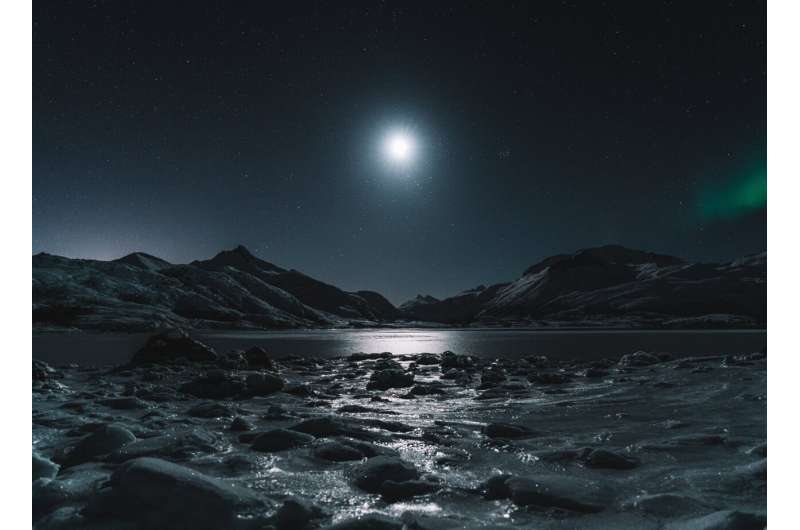This article has been reviewed according to Science X's editorial process and policies. Editors have highlighted the following attributes while ensuring the content's credibility:
fact-checked
peer-reviewed publication
trusted source
proofread
Following a star: Study explores the remarkable ways traditional cultures use their environment to navigate

A study has shed new light on remarkable feats of navigation from cultures across the world: from sailors in the Marshall Islands using wave patterns to navigate the vast Pacific Ocean to indigenous communities in Alaska using stars to find their way across the Yukon.
The study, by researchers from the University of York and University College London, aims to show what Western science can learn from exceptional navigators using traditional techniques, some of which have been in use for thousands of years.
It highlights the overlooked role of culture and close connection with the environment in the art and science of wayfinding in complex landscapes, where there are often no paths or landmarks, and mistakes can be fatal.
The authors of the study say these idiosyncratic methods for solving navigational challenges offer important new insights for the way navigation is understood in cognitive science research.
Co-lead author of the study, Dr. Pablo Fernandez Velasco, a British Academy postdoctoral fellow from the Department of Philosophy at the University of York, said, "The feats of navigation in our paper describe some methods of wayfinding that are so skilled they seem implausible to many of us who rely on GPS to find our way almost everywhere."
"The incredible techniques we explored are at risk of being lost in a world that heavily relies on technology and faces rapid changes in the natural environment due to climate change. Many of the cultures highlighted in our study are particularly vulnerable to the impacts of rising sea levels and changing landscapes and weather patterns."
"Our study shifts the way we think about how the brain remembers where things are located. Instead of just focusing on how our minds store those memories, western science should begin to view navigation as a dynamic, action-oriented skill that involves a mix of different senses, ways of thinking, and problem-solving strategies."
The review profiles navigation techniques that use a range of skills and senses from 49 populations in 30 nations around the world.
Co-lead author Professor Hugo Spiers from University College London said, "It was a joy to create the first world map revealing where these different traditional communities were and the diversity of environments reported on. We hope this will aid future researchers exploring this topic."
Techniques profiled in the study include:
- Sailors in the Marshall Islands use wave piloting to navigate the open ocean in the Pacific. Navigators decide on an initial course based on their knowledge of the configuration of islands and then use changes in the rhythmic motion of the canoe to sense the transformation of wave patterns.
- The Gwich'in indigenous community in Northern Alaska use the stars to find their way in the vast Yukon Flats. The unusual strategy involves looking at the night sky and projecting different stars onto attributes of the mythical fox-like creature Yahdii. The stars form the tail, leg, or snout of Yahdii, and each guides the traveler to different regions of the flatlands.
- For the Batek people of Malaysia, auditory cues such as birdsong help them to know where they are in the rainforest. This is an important skill, as the rainforest is visually impenetrable after a few meters.
The study also looks at the techniques of experts who follow local navigational traditions within western culture and in urban environments, such as London licensed taxi drivers. Without GPS, these taxi drivers need to be able to plan the shortest route between any two places in a city of nearly 26,000 streets.
To do this, they combine two types of visualization techniques: they picture the map of London from a bird's eye view, charting subgoals along it, and they use their in situ experience to simulate in-street views of the route.
Dr. Fernandez Velasco added, "From the labyrinthine streets of London to the southeast coast of Greenland, we have found consistent evidence for how the diversity of landscapes in which humans dwell is mirrored in the diversity of navigational cultures. Current research on navigation within the cognitive sciences doesn't reflect this diversity."
"Future research can not only help us to understand human behavior more deeply, but it can also help us understand, preserve, revive, and adapt incredibly rich cultures of navigation that play an important role in connecting people to their local environments."
The research is published in the journal Trends in Cognitive Sciences.
More information: Pablo Fernandez-Velasco et al, Wayfinding across ocean and tundra: what traditional cultures teach us about navigation, Trends in Cognitive Sciences (2023). DOI: 10.1016/j.tics.2023.09.004
Journal information: Trends in Cognitive Sciences
Provided by University of York




















